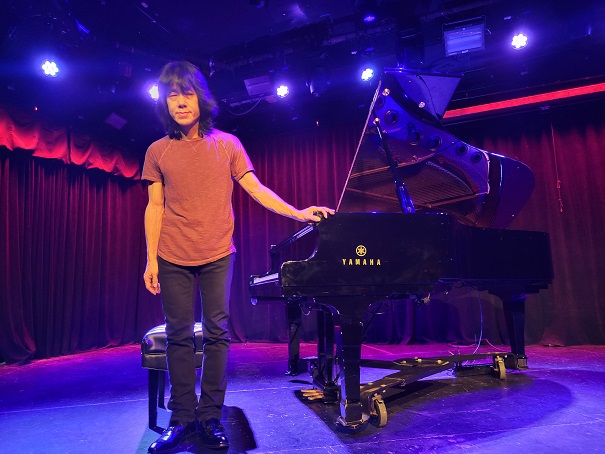Concert Diary: Taka Kigawa Plays Ligeti and Boulez
Septemer 23, 2021
New York, N.Y.
French composer Pierre Boulez and Hungarian-Austrian composer György Ligeti were born within two years of each other, and they were both hardcore modernists, yet their music could never be mistaken for each other. Even without the program notes, it would have been easy to separate the two composers in the concert last night of their piano music by pianist Taka Kigawa at (Le) Poisson Rouge.
(Le) Poisson Rouge — its preferred punctuation style — is on the site of the former Village Gate on Bleeker Street and still resembles a jazz club. The stage is in a corner, tables are available for seating, and a long bar at one end exists for those who prefer listening to music on a barstool with a drink in hand. Those of us who sit at the tables are required to buy drinks or food from a menu definitely not as good as it used to be several years ago. Last night, everyone had to provide proof of vaccination and wear face masks.
Taka Kigawa has been at (Le) Poisson Rouge before. I’ve seen him there focusing on the modern part of the spectrum of his extensive repertoire, playing Boulez, Messiaen, Xenakis, and John Luther Adams. His program yesterday evening consisted of Pierre Boulez’s 2nd and 3rd Piano Sonatas, and a selection from György Ligeti’s three books of Piano Études.
Taka began with the most difficult work first: Boulez’s Piano Sonata No. 3, which Boulez began in 1955 to 1957, and them came back to in 1964. It was intended to consist of five movements (called “formants") but only two were published in their entirety, leaving it essentially unfinished. Each of the movements has several short sections; the first (called Antiphonie) allows the pianist to choose an “itinerary” through the work. For this movement, Taka played from individual pages of the score, moving each to a small table after completing it. For the remainder of the work (movements called Trope and Constellation-Miroir) — and the remainder of the concert — Taka played from memory, which is an astounding feat.
I’ve never been able to get a grasp on Boulez’s mysterious and problematic Third Sonata. It is sparser, more fragmented, seemingly more hesitant than Boulez’s other music, offering (at least to me) only glimpses of what could have been a longer and more coherent work.
From there, Taka played eight of Ligeti’s Piano Études. In general, the music of Ligeti is more accessible than Boulez, and often suffused with humor. These Piano Études are great fun, offering a variety of moods and tempos, with textures ranging from Debussyan auras to the frenetic rhythmic insanity of Conlon Nancarrow’s piano rolls.
Taka concluded his concert with Boulez’s 2nd Piano Sonata, which Boulez began in 1947 as a 22-year-old composer with very strong opinions regarding the future direction of music. It still has the reputation of being a challenging work, but with familiarity (and aided by analyses such as composer Samuel Andreyev’s analysis on YouTube), it has come to be a comprehensible and yes, an enjoyable work.
Boulez’s 2nd Piano Sonata has a classical four-movement structure. The first movement is in sonata-allegro form using contrasting texture types; the second is a traditional slow movement in a theme and variations format. It is intensely defiantly and lyrical with surprising outbursts. The third movement is just a couple minutes long, skittering around with the feeling of a scherzo, and getting less hectic in the “trio” sections. The finale supposedly includes a fugue (although I can’t hear it) but towards the end rushes ahead with a thrilling urgency, but evolving into a coda that gets quite contemplative and fades out in a whisper.
It was apparently Boulez’s intention to stretch the piano sonata so far as to destroy it as a musical form, but what he did in the Second Piano Sonata has come to be an enduring contribution to the genre.
